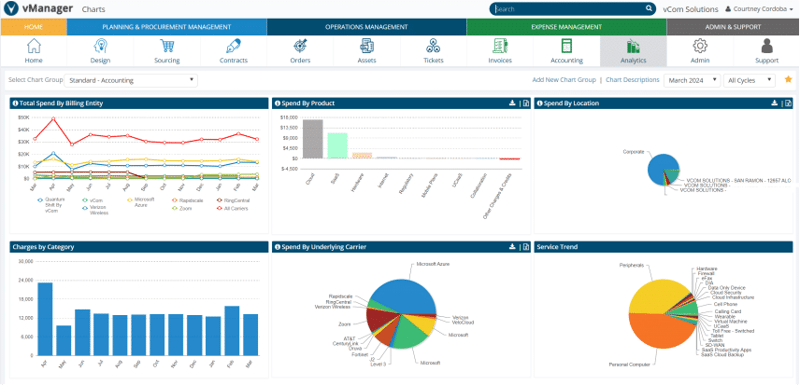IT professionals across sectors face a lot of exciting challenges these days. From constant time constraints due to the mountain of duties needed to be done, dealing with budget limitations, to dealing with information overload, IT professionals have a lot on their plates. Most of this can be solved or streamlined through an effective IT lifecycle management process or tool. Statista predicts that 75% of companies will adopt big data analytics, cloud computing, e-commerce and digital trade, and AI technologies to help with lifecycle management between 2023 and 2027.
Believe it or not, it’s 100% possible to simplify IT lifecycle management so everything from source to pay is running smoothly. That is the whole point of this blog post: To show you why it’s so important and how effective lifecycle management allows you to cut costs, have more time, and see the data you need to make optimized decisions.
Let’s talk about it.
Understanding IT Lifecycle Management
First, let’s define what it is and why it’s important. IT Lifecycle Management is a comprehensive approach to managing all aspects of an organization’s information technology systems. It includes not just the hardware and software but also the policies and processes that support them throughout their lifecycle, from selection and procurement through to disposal.
It covers all your bases, which is why so many IT professionals get lost in the chaos of trying to manage it. It takes time, which eventually costs the organization money. And with all the moving pieces of the IT lifecycle, important information tends to slip through the cracks.

The Necessity for Lifecycle Management in IT
Everything in IT requires lifecycle management. This includes tangible assets like servers, desktop computers, mobile devices, peripherals and intangible assets like software licenses and data. Effective management of these assets ensures they are up-to-date, performing optimally, secure, and compliant with various regulations.
Key Phases of the IT Lifecycle

- Planning and Procurement: This initial phase involves identifying the need for new IT assets and outlining the requirements before proceeding with the procurement. It requires a strategic approach to choose solutions that best align with the organization’s objectives and budget constraints. Where these solutions and assets are sourced as well as their contracts also need to be well documented and monitored.
- Operations Management: Once the assets are procured, the focus shifts to ensuring their optimal performance. This phase covers deployment, inventory management, maintenance, and support – all geared toward maximizing uptime and efficiency.
- Expense Management: A crucial yet often overlooked aspect, expense management involves tracking the costs associated with each IT asset throughout its lifecycle. This includes initial acquisition costs, operating expenses, and any spending on upgrades or repairs. Tracking the invoices for all of this tends to be one of the more tedious jobs of IT lifecycle management.
The Benefits of Effective IT Lifecycle Management
Having a good handle on all of this can significantly enhance an organization’s efficiency and operational effectiveness. By tracking and managing the stages of each IT asset – from procurement to expense management – organizations can ensure they have the best possible ROI for their technology investments. Having this oversight can streamline processes, reduce downtime through proactive maintenance, and improve budgeting accuracy by forecasting future needs and potential upgrades.
The bottom line is that effective IT lifecycle management helps businesses adapt to new technologies and market demands to maintain their competitive edge. Need more convincing? Let’s break it down a little more.
Three key areas will greatly improve when IT lifecycle management is working effectively. For the sake of these examples, let’s look at them as if there is a tool in place that helps with IT lifecycle management:
Saving More Time
Having an IT lifecycle management tool can be a huge time saver for businesses, especially because it streamlines and automates several critical functions.
- Automation of Routine Tasks: For example, imagine your IT team no longer needs to manually monitor your network circuits across hundreds of devices, if you’re even monitoring it to begin with. Instead, the lifecycle management tool automatically monitors and alerts you when a circuit is down, freeing up valuable time for IT staff to focus on strategic initiatives. Tasks such as GL coding and generating an AP posting file can be automated as well, supporting your accounting team.
- Centralized Management: Consider a scenario where all contracts, orders, assets, and invoices are managed from a single dashboard. This means you no longer have to navigate through multiple systems to track down issues, manage assets, and pay invoices. Everything you need is accessible from one centralized interface, saving considerable time and effort.
- Invoice Standardization: A huge problem IT teams deal with are the numerous and complex invoices they have to deal with on a monthly basis. There simply is not enough time to properly check every invoice for accuracy, due both to the number of invoices and the lack of standardized language across different carriers. A good lifecycle management tool can take all your invoices, standardize the language, and even check for inaccuracies, drastically reducing the time needed to comprehend and process invoices.

- Improved Process Workflow: Another facet of good lifecycle management is standardizing procedures for tasks such as contract approval and MACD order management, which allows IT professionals to work more efficiently. Consistency in procedures reduces the time spent troubleshooting errors or inconsistencies resulting from ad-hoc approaches, allowing IT professionals to accomplish tasks more quickly and reliably.
Making More Money
Yes, having a tool in place that prioritizes and streamlines IT lifecycle management can help any organization bring in more revenue and save money on all the costs that are associated with IT. Here are a few examples:
- Increased Productivity: By automating routine maintenance and management tasks, these tools free up IT staff to focus on initiatives that drive business growth, such as developing new solutions or optimizing existing processes. For example, developers can dedicate more time to creating innovative software solutions that meet customer needs. This increased productivity leads to faster product development cycles, allowing the company to release new features and updates more quickly, ultimately driving revenue growth.
- Cost Efficiency: IT lifecycle management tools provide detailed insights to help rightsize your IT environment and get rid of technology sprawl. This data helps organizations avoid overprovisioning and underutilizing resources, ensuring that investments are made wisely. Take mobile devices. These tools can identify overutilized data, where certain employees may be consuming excessive amounts of mobile data unnecessarily. By implementing data usage policies or offering training sessions to educate employees on efficient data usage practices, the organization can optimize its data consumption and reduce unnecessary spending on data plans. Similarly, underutilized data plans can be identified and adjusted to match actual usage patterns, overall saving money on business wireless bills.

- Extended Asset Lifespan: Effective management of IT assets prolongs their lifespan, delaying the need for costly replacements and allowing the business to maximize the returns on its technology investments. Imagine a telecommunications company that utilizes IT lifecycle management tools to manage its network infrastructure, including circuits, routers, and switches. By monitoring network traffic, identifying potential bottlenecks, and implementing proactive maintenance measures, the company prolongs the lifespan of its network equipment. This ensures consistent network performance and reliability, reducing the need for costly equipment upgrades or replacements.
Getting Better and More Accurate Information
It should go without saying that having an automation tool in place that specifically helps with IT lifecycle management can reduce a significant amount of human error, resulting in more quality and accurate information being shared.
- Real-time Monitoring and Reporting: These tools often feature real-time monitoring capabilities that continuously track the performance and health of IT assets. The data collected is up-to-date and reflects current conditions, which helps in making informed decisions quickly. Real-time reports can reveal trends and patterns that might not be visible with less timely data. As mentioned earlier, good lifecycle management tools can monitor bandwidth usage, latency, and packet loss in real-time, providing network administrators with immediate insights into network health and performance. If a circuit experiences congestion or downtime, administrators receive instant alerts, allowing them to quickly troubleshoot and resolve issues to minimize service disruptions.
- Automated Data Collection and Updates: Manual data entry is prone to errors and often outdated. IT lifecycle management tools automate the collection and updating of data, reducing the likelihood of errors and ensuring that the data is current. Going back to the previous example, IT lifecycle management tools can automate the collection and updating of asset data for your circuits. For example, when new circuits are deployed or decommissioned, the tools automatically update the asset inventory database with relevant information such as device serial numbers, maintenance schedules, and warranty expiration dates, removing any errors coming from manual data entry or outdated information.

- Enhanced Analytical Capabilities: Advanced analytical tools built into many IT lifecycle management solutions allow organizations to process large volumes of data to generate more precise insights and forecasts. By generating charts and graphs depicting month-to-month spending patterns, these tools can provide insights into cost drivers and opportunities for optimization. For example, a pie chart might illustrate the distribution of spending across different types of service providers, highlighting areas where consolidation or renegotiation may be beneficial. By monitoring spend trends over time, IT procurement managers can optimize vendor relationships, negotiate favorable terms, and reduce overall telecommunications costs.

How This Affects Network and Mobile Lifecycle Management
Your network and mobile (NLM and MLM) are two of the biggest IT focuses. Here’s what good lifecycle management means specifically for your network and mobile environment.
When IT lifecycle management is handled well, the network infrastructure always aligns with the organization’s needs, supporting optimal performance and security. Regular updates and replacements as part of the IT lifecycle ensure that the network can handle evolving demands, from increased data loads to integrating new technologies.
Similarly, Mobile Lifecycle Management benefits from robust IT lifecycle management practices. Mobile devices are critical to business operations. Effective management of these assets ensures they’re secure, up-to-date, and functioning efficiently.
Simply put, these two IT management pillars help establish a better technology strategy for the whole organization.
Actionable Takeaways
For IT managers aiming to enhance their IT lifecycle management, consider these practical steps, leveraging the right tools:
- Evaluate and record the current state of your IT assets, including their stages in the lifecycle.
- Establish a centralized system for tracking to enable real-time oversight and management of IT assets.
- Consistently revise and refresh your IT policies and procedures to keep pace with evolving best practices and compliance standards.
If your internal capabilities are stretched thin, consider outsourcing parts of your IT lifecycle management. Working with a specialized provider can bring in-depth knowledge and cost benefits.
Conclusion
Getting a handle on IT lifecycle management helps you save money, make better decisions, and get your time back to focus on core initiatives. By taking the actionable steps talked about in this article—like keeping a close eye on your IT assets, having a solid system to track them, and staying up-to-date on the best practices—you’re setting your organization up for success. While it can be a lot to handle, having a tool that specifically helps with everything that goes into IT lifecycle management can be a huge help.



